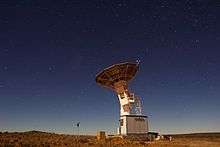C-Band All Sky Survey
 C-BASS North at Owens Valley Radio Observatory | |
| Alternative names | C-BASS |
|---|---|
| Survey type |
Astronomical survey |
| Target |
Milky Way |
| Observations |
C-BASS North, C-BASS South |
| Wavelength |
6 centimetre |
| Frequency |
5 gigahertz |
| Website |
cbass |
|
| |
The C-Band All Sky Survey (C-BASS) is a radio astronomy project that aims to map the entire sky in the C Band (5 GHz). It is to be conducted on two radio telescopes, one operating in the Karoo in South Africa, and the other one in California.
Project description

The survey is a collaboration between the University of Oxford, University of Manchester, the California Institute of Technology, the Hartebeesthoek Radio Astronomy Observatory (HartRAO), and the King Abdulaziz City for Science and Technology. The observations are being made with two telescopes; one based at the Owens Valley Radio Observatory (OVRO) in California, United States, and the other near Klerefontein in the Karoo desert in South Africa.[1]
For an all sky survey two ground-based telescopes are required, one in the southern and one in the northern hemisphere.[1] C-BASS North is a 6.1m Gregorian telescope, the dish was donated to the project by the Jet Propulsion Laboratory and it has started performing survey observations. C-BASS South is a 7.6-m Cassegrain telescope with a dish donated by Telkom (South Africa). It is currently in the final stages of commissioning at Hartebeesthoek Radio Astronomy Observatory and is forecast to begin survey observations in 2014 when it is deployed in the Karoo. The secondary mirrors on both telescopes are supported by cones of radio-transparent foam to minimize the contamination from ground pick up and to avoid scattering the incoming polarized radiation.[1][2]
Scientific goals
The survey will map not only the intensity but also the orientation of the incoming electromagnetic waves (polarization) at every point on the sky with an angular resolution of 0.73 degrees. The angular resolution represents the smallest details that can be distinguished in the images. It is the first survey to map the sky at a frequency of 5 GHz—low enough to be synchrotron radiation dominated but high enough to be relatively unaffected by Faraday rotation. At this frequency most of the signal is coming from emissions from high-energy electrons spiraling around magnetic fields in the galaxy. This radiation is highly polarized and a major foreground distorting the Cosmic Microwave Background (CMB) signal.[3]
The primary scientific goal of the project is to aid in the subtraction of foreground radiation, mainly from our own galaxy, from measurements of the CMB in order to improve the exactness of the CMB measurements. The CMB is polarized, this polarization can help shed light on inflation theory and gravity waves in the early universe. Secondary goals include studying the magnetic fields within the Milky Way, the WMAP Haze and spinning dust.[2]
References
- 1 2 3 Square Kilometer Array Media Release, South Africa.
- 1 2 King,, O.G.; et al. (2010). "The C-Band All-Sky Survey: Instrument design status and First-look data". Millimeter, Submillimeter, and Far-Infrared Detectors and Instrumentation for Astronomy V. arXiv:1008.4082. doi:10.1117/12.858011.
- ↑ Holler, Christian M; et al. (28 August 2012). "A Circularly Symmetric Antenna Design With High Polarization Purity and Low Spillover". IEEE Transactions on Antennas and Propagation. 61: 117–124. arXiv:1111.2702. Bibcode:2013ITAP...61..117H. doi:10.1109/TAP.2012.2219843.